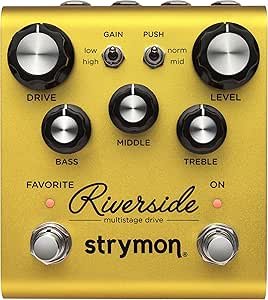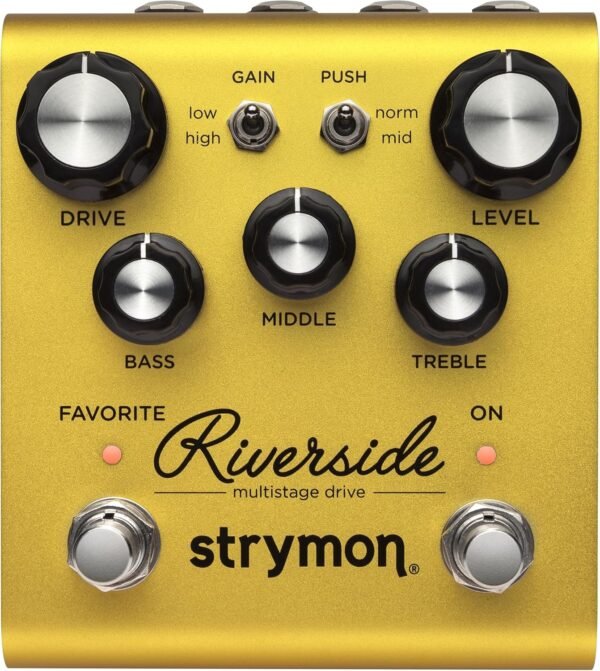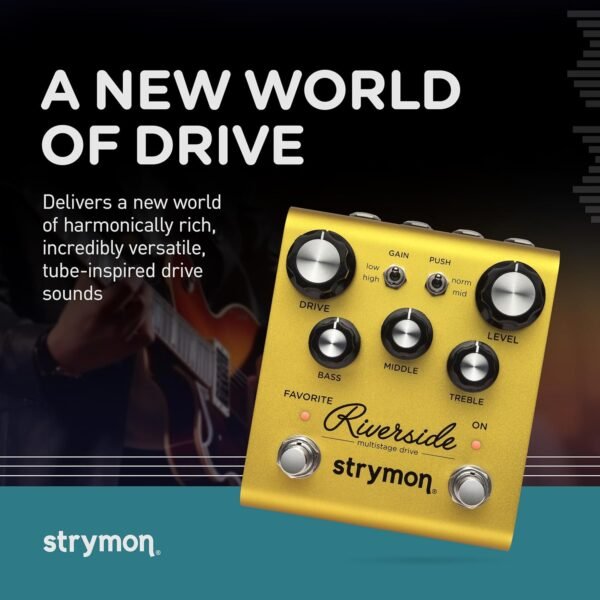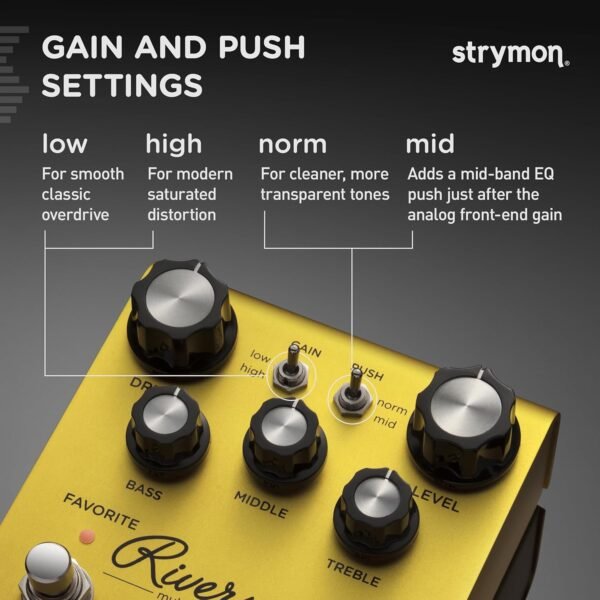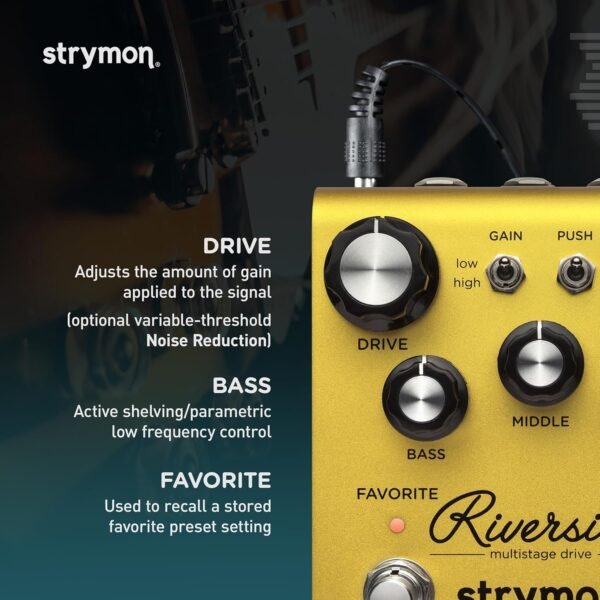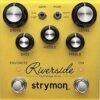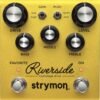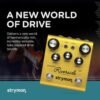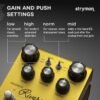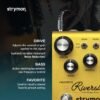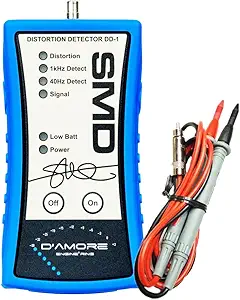Strymon Riverside Guitar Effects Pedal Review Versatile Overdrive for Electric and Acoustic Guitars
Strymon Riverside Guitar Effects Pedal Review Versatile Overdrive for Electric and Acoustic Guitars
- Exceptional tonal versatility allows seamless transition from subtle overdrive to rich, saturated distortion.
- The responsive dynamic range adapts beautifully to your playing style, providing a genuine tube-like experience.
- Built-in 3-band EQ ensures precise sound customization to suit any musical setup.
- The presence switch makes it remarkably adaptable to different amplifiers, maintaining clarity and balance.
As an Amazon Associate I earn from qualifying purchases.
Description
A New World of Sound with the Strymon Riverside Multistage Drive Pedal
The Strymon Riverside Multistage Drive Guitar Effects Pedal is a product that caught my attention not just for its sleek, compact design but for its promise of delivering harmonically rich, tube-inspired tones. Whether you’re playing an electric guitar, acoustic guitar, or even a synth, this device is supposed to adapt and enhance your sound. I tested it thoroughly and found some impressive features, though there are a few things to consider.
Design and Build Quality
The first thing I noticed was how solid this pedal feels in hand. Weighing just 1.35 pounds, it’s lightweight yet boasts a sturdy build that doesn’t feel cheap at all. Its yellow finish adds a pop of color, making it stand out on a pedalboard. With dimensions of 8 x 5 x 4 inches, it fits snugly into most setups without hogging space. The knobs and switches feel durable, and the three-position Presence switch is particularly smooth to operate. While testing it in a practice session, I appreciated the ergonomic layout of the controls, as they were intuitive to tweak on the fly.
Tone Versatility and Gain Stages
One of the pedal’s standout features is its cascading gain stages, which deliver a range of tones from clean overdrive to full-on distortion. I was amazed at how the analog Class A discrete JFET front end responded dynamically to my playing. For example, when I played softly, the tones remained clean and warm, but as I dug into the strings, the pedal amped up the grit beautifully.
The variable circuit tuning deserves a special mention. It adjusts parameters dynamically as you tweak the Drive knob, ensuring that the “sweet spot” follows you across all gain levels. I tested this by dialing through mild overdrive and high-gain leads, and it truly felt like the pedal was catering to my playing style. Precision DSP adds complexity and harmonics, enhancing the richness of the sound.
Precise Tone Customization
The 3-band EQ (Bass, Middle, and Treble) is a game-changer. Unlike pedals that offer vague tone controls, this one provides precise shaping options. I used the EQ to tailor my sound depending on the amp I was plugged into. For instance, when paired with a darker amp, boosting the Treble and Middle knobs brought out clarity and presence in my tone. On a brighter amp, dialing back the Treble while enhancing the Bass added warmth without losing detail.
The Presence switch is another nifty feature. I tested it with different amps, including a vintage Fender and a modern Marshall, and the pedal adapted seamlessly. Whether the amp was naturally bright or dark, I could fine-tune the high frequencies for a balanced sound.
Key Benefits
- Harmonic Complexity: The cascading gain stages and DSP create harmonically rich tones that elevate your sound.
- Dynamic Response: The analog Class A discrete JFET front end responds beautifully to playing dynamics.
- Versatile EQ: The 3-band EQ allows for precise tone shaping, adapting to any amp or setup.
- Sweet Spot Tracking: Variable circuit tuning ensures consistently great tone across all settings.
- Solid Build: Lightweight yet durable, with an intuitive control layout.
Areas for Improvement
While the pedal is fantastic overall, a few things could be better:
- Power Requirements: It demands a 9-volt power source but doesn’t come with a power adapter in the box, which felt like a miss.
- Pricing: The cost might deter casual players or beginners.
- Learning Curve: The advanced features might overwhelm those used to simpler pedals.
Product Alternatives
In a market flooded with overdrive and distortion pedals, the Riverside faces stiff competition. I compared it to the Fulltone OCD and Boss DS-1, two popular options. The Fulltone offers a similar level of dynamic response but lacks the DSP-powered harmonic richness that the Riverside excels in. On the other hand, the Boss DS-1 is more affordable but leans heavily toward distortion, offering less versatility for clean or mild overdrive tones.
What sets the Riverside apart is its infinite sweet spot tracking and versatile EQ, features not commonly found in its competitors. However, if budget is a concern, pedals like the MXR Timmy might be worth exploring, though they don’t quite match the Riverside’s tonal range.
Price to Quality Ratio
The Riverside is definitely on the premium side, but it delivers on its promises. For players who value versatility and tone precision, this pedal is worth the investment. While it might not appeal to those just starting out, anyone serious about their sound will find it to be a cost-effective choice in the long run. Its ability to adapt to different setups and amps makes it a reliable addition to any gear collection.
Final Thoughts
The Strymon Riverside Multistage Drive Pedal has earned its spot on my pedalboard. Its blend of analog warmth and digital precision offers a tonal palette that’s hard to match. While it’s not without its quirks, it’s a pedal that rewards those who take the time to explore its capabilities. Whether you’re playing blues, rock, or even experimenting with synths, this device has the versatility to inspire creativity.
Additional information
| Item Weight | 1.35 pounds |
|---|---|
| Product Dimensions | 8 x 5 x 4 inches |
| Item model number | Riverside |
| Color Name | Yellow |
| Hardware Interface | HP-HSC |
| Signal Format | Analog |
| Power Source | Corded Electric |
| Voltage | 9 Volts |
